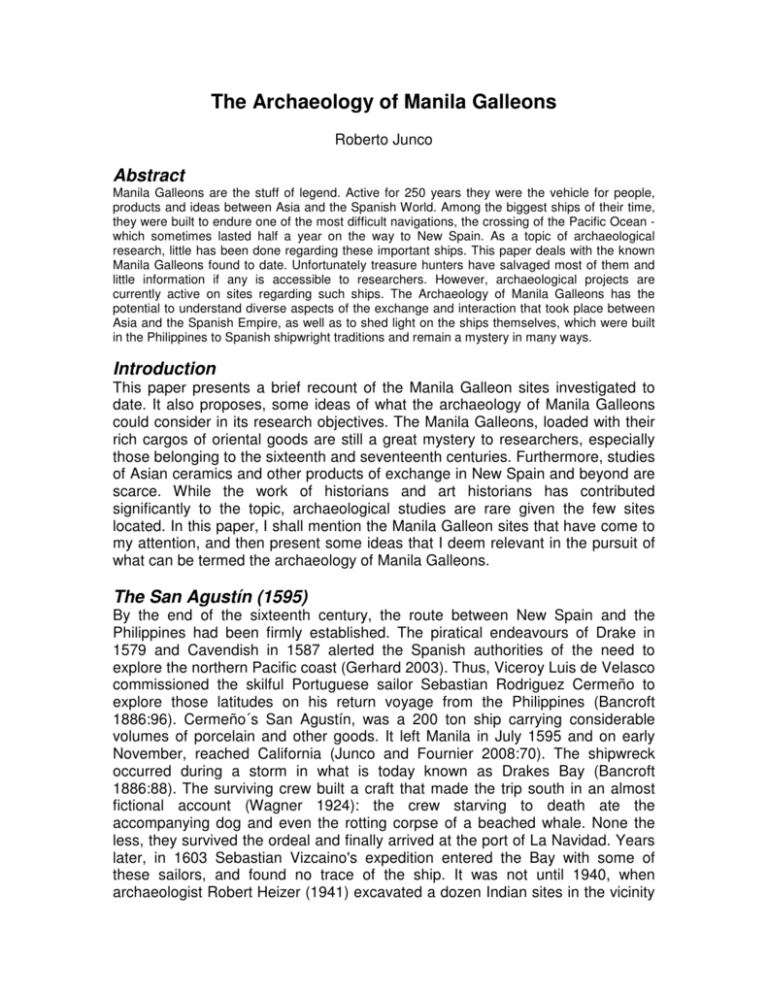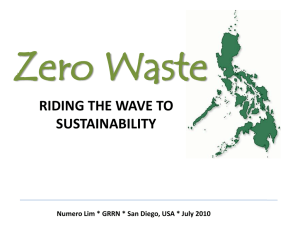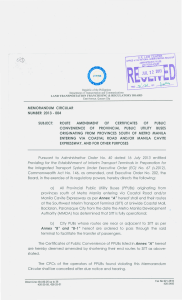The Archaeology of Manila Galleons
advertisement

The Archaeology of Manila Galleons Roberto Junco Abstract Manila Galleons are the stuff of legend. Active for 250 years they were the vehicle for people, products and ideas between Asia and the Spanish World. Among the biggest ships of their time, they were built to endure one of the most difficult navigations, the crossing of the Pacific Ocean which sometimes lasted half a year on the way to New Spain. As a topic of archaeological research, little has been done regarding these important ships. This paper deals with the known Manila Galleons found to date. Unfortunately treasure hunters have salvaged most of them and little information if any is accessible to researchers. However, archaeological projects are currently active on sites regarding such ships. The Archaeology of Manila Galleons has the potential to understand diverse aspects of the exchange and interaction that took place between Asia and the Spanish Empire, as well as to shed light on the ships themselves, which were built in the Philippines to Spanish shipwright traditions and remain a mystery in many ways. Introduction This paper presents a brief recount of the Manila Galleon sites investigated to date. It also proposes, some ideas of what the archaeology of Manila Galleons could consider in its research objectives. The Manila Galleons, loaded with their rich cargos of oriental goods are still a great mystery to researchers, especially those belonging to the sixteenth and seventeenth centuries. Furthermore, studies of Asian ceramics and other products of exchange in New Spain and beyond are scarce. While the work of historians and art historians has contributed significantly to the topic, archaeological studies are rare given the few sites located. In this paper, I shall mention the Manila Galleon sites that have come to my attention, and then present some ideas that I deem relevant in the pursuit of what can be termed the archaeology of Manila Galleons. The San Agustín (1595) By the end of the sixteenth century, the route between New Spain and the Philippines had been firmly established. The piratical endeavours of Drake in 1579 and Cavendish in 1587 alerted the Spanish authorities of the need to explore the northern Pacific coast (Gerhard 2003). Thus, Viceroy Luis de Velasco commissioned the skilful Portuguese sailor Sebastian Rodriguez Cermeño to explore those latitudes on his return voyage from the Philippines (Bancroft 1886:96). Cermeño´s San Agustín, was a 200 ton ship carrying considerable volumes of porcelain and other goods. It left Manila in July 1595 and on early November, reached California (Junco and Fournier 2008:70). The shipwreck occurred during a storm in what is today known as Drakes Bay (Bancroft 1886:88). The surviving crew built a craft that made the trip south in an almost fictional account (Wagner 1924): the crew starving to death ate the accompanying dog and even the rotting corpse of a beached whale. None the less, they survived the ordeal and finally arrived at the port of La Navidad. Years later, in 1603 Sebastian Vizcaino's expedition entered the Bay with some of these sailors, and found no trace of the ship. It was not until 1940, when archaeologist Robert Heizer (1941) excavated a dozen Indian sites in the vicinity and found traces of iron and Chinese porcelain. In 1982 the Submerged Cultural Resource Unit (SCRU) of the National Park Service (NPS) carried out a survey with a magnetometer in the bay, possibly identifying the wreck site (Delgado 1998:357). A few years later, Robert Marx got a license to exploit commercially the wreck, but the strong position of NPS officials stopped the treasure hunter who planed to sell some of the artefacts found (Ibid.). Some of the porcelain picked up by beachcombers has been studied and compared to other collections such as the Drake cargo, helping to establish a chronology (Shangraw and Von der Porten 1981; Shangraw and Von der Porten 1997; Von der Porten 1972). Nuestra Señora de la Concepción (1638) In 1990, the popular magazine National Geographic published an article about the salvage operation of the Manila Galleon Nuestra Señora de la Concepción, which sank on route to Acapulco in 1638 (Mathers 1990). Pacific Sea Resources undertook the salvage operation between 1988 and 1999 with the intention to sell the entire collection to a Japanese hotel chain with plans to create a touristic project on the island of Saipan in the Northern Mariana Islands (Delgado 1998:277). The wreck site was known since 1674, when a Spanish recovery expedition secured most of the 36 cannons on board (Mathers 1993:33). This type of salvage operation was very common throughout the Spanish empire and not just by the Crown, but also by commercial contracts (Serrano 1991). Thus, thanks to the historic document and the Chinese porcelain washed out in the beach, treasure hunters located the archaeological site (Galvan 1998:88). The ship sank while the crew brewed a mutiny in the midst of a great storm that destroyed the masts, and left the ship at the mercy of wind and currents (Mathers 1993:29). On September 1638, the Concepción broke up on a southern reef of the island of Saipan (Mathers 1990:45). The Chamorro Indians (given this name by Magallanes) attacked the castaways and only 28 survived of which only six finally arrived to the Philippines starved and thirsty to tell the story (Schurtz 1992:236). Several years later, priests visiting the islands found gold chains hanging from the trees and iron tools being used by the natives (Fish 2011:14). Among the many objects recovered by the operation, is a collection of gold objects such as rings, chains, and other objects, some Chinese coins of the Wan Li period (1573-1620), and a sixteenth-century Spanish silver coin. Among the highlights of the collection are the 156 glazed Southeast Asian ceramic containers used to transport supplies, with interesting markings in Spanish, Tagalog and Chinese, as well as fragments of porcelain and glass, and a number of objects related to the construction and operation of the ship (Mathers, et al. 1990). Santa Margarita (1601) In 1995, the Seattle based company IOTA Partners got a permit to salvage the Santa Margarita wrecked off the island of Rota in the Northern Mariana Islands. It is not entirely clear what their work has been - although there is a report that I have not been able to consult (IOTA Partners 1996). What can be said is that they have had legal problems, because of violations of contract with the local government involving the destruction of part of the reef where the galleon is located (Deposa 2006). Several pieces of ivory, porcelain and gemstones have been recovered (Shen 2007). An anchor from the ship has been located and rests in the ocean (Galvan 1998:93). The ship sank in 1601 with a crew of over 300, however only a few survived the incident (Driver 1983:200). The following year, a galleon that carried the missionary Fray Juan Pobre de Zamora, came into contact with a survivor of the Santa Margarita, that shared information with him about the Chamorro Indians (Ibid.). Nuestra Señora del Pilar (1690) The Manila Galleon, Nuestra Señora del Pilar de Zaragoza, sank off the island of Guam in 1690 on route to the Philippines. It has a history that resembles the Nuestra Señora de la Concepción in that it was also salvaged at the time and has been pursued by several treasure hunters such as the Australian company Maritime Archaeological Investments, Pilar Proyect Ltd. (related to the former) (Surry 2001). In 1989, they located in the Archivo General de Indias in Seville the record of 5000 silver coins recuperated from the wreck. According to this document (Cruzat 1700), the three hundred ton galleon lost the majority of the crew in the event. Supposedly, Tresure hunters have only found 36 silver coins minted in Mexico City, Lima and Potosi, several sheets of lead belonging to the hull, timber, iron nails, cannon balls and musket shot, and five tons of stone ballast (Surry 2001). Further more, iron fasteners, hundreds of fragments of olive jars and three claws from Mexican black bears have been recovered in continuos operations (Showronek 2009:497). According to The New York Times (Richardson 2001), in 2001 they went on the hunt for investors in Australia to raise half a million dollars to finance their operations The San Diego (1600) The San Diego, built on the island of Cebu, sank in battle against the Dutch near Manila in 1600 and is often cited as a Manila Galleon (Brown 2009:178). The wreck was located by Franck Goddio of the Far Eastern Foundation for Nautical Archaeology in partnership with archaeologists of the National Museum of the Philippines (1994; see Orillaneda and Ronquillo this volume), who recovered more than a thousand pieces of blue and white Wan Li porcelain, Japanese sword guards, 570 storage jars (the largest collection found to date), a gold and ivory crucifix, a brass astrolabe (only six known prior to 1600), a glass and bronze compass (one of the few in those days), gold rings, cannons, anchors and other artefacts (Harper 2010). It is true that the San Diego shares common features with the ships that are the subject of this work, however it should not be considered as such, because the ship was on a combat mission and in that sense, at the time of sinking it was not fulfilling the functions of a Manila Galleon if ever it was intended to. The Manila Galleon in Oregon Archaeological evidence of a Manila Galleon has been located on the west coast of the United States in Nehalem, Oregon. Preliminary investigations point to a ship of the late seventeenth or early eighteenth century, and two candidates are already proposed, the Santo Cristo de Burgos (lost in 1693), or the San Francisco Xavier (lost in 1705), whose contemporary testimony is as follows, Nothing has been heard from it, nor a plank, or object of any kind, big or small, has served as clue to speculation that it crashed into an unknown rock or that it was swallowed up by the waves with all that was on board [….] The Ocean kept the secret of this horrific tragedy (Fernandez 1898). The on going project, called "Beeswax Wreck" is currently headed by Scott Williams, a specialist in the area of Cultural Resources at the Service of Natural Resources in Washington State, and has the support of volunteers and researchers who have analyzed the archaeological material collected to date (Williams 2006). Since the nineteenth century, wax blocks have been documented in the area, some with interesting markings engraved on them. The marks have been compared with those recorded in ceramics from the shipwrecks of Nuestra Señora de la Concepción and the San Diego already mentioned, finding some similarities (Rogers 2008). In addition, work has been done on the porcelain recovered from the site, concluding that it dates to the early Kangshi period (1662-1722) (Lally 2009). Also, studies have been done on wooden nautical items recovered in the coastal dunes confirming an oriental origin, teak (Williams 2009). Interestingly, oral histories have been recorded that testimony Indians in the area who claim to be descendants of shipwrecked sailors, some with European features (Williams 2010). The Manila Galleon in Baja California For 12 years now, there have been several field seasons by American researchers and the Instituto Nacional de Antropología e Histoira (INAH) in the Pacific coast of Baja California, where thousands of pieces of Chinese porcelain dating to the sixteenth century, as well as coins, blocks of wax, and other objects, whose origin no doubt, is a Manila Galleon shipwreck have been documented (INAH 2005; INAH 2007; INAH 2009; INAH 2010). The porcelain collection is one of the most important in Mexico and opens a window into the early trade of the New Spain and Asia. In July 1751, the tireless Jesuit missionary Father Consag, in his explorations of Baja California records the site: By mid morning those who went to survey the spit of sand brought a bowl, a cup, a big cup, a plate of Chinaware and a good portion of white wax paste. They informed that the area is full of vases, large plates and the like, nails and pieces of iron that disintegrate into powder with contact, even the nails that are still tucked into the broken timbers; lead pieces can be found, several medium and small pieces of bronze, but what is more abundant and easily found is the wax. For lack of water they cannot stop for much time, because the nearest is very salty, and if it does not give thirst, it does not quench it. All these things, clearly indicate that in this sandy beach or contours, a vessel sank, which can even happen without a big storm, or because the coast is unknown (Ortega 1887:524). Although there are historical records of the site, as the one above, it was ultimately the archaeological material found by beachcombers that led to the investigations by Maritime Historian Edward Von der Porter -who had analyzed the porcelain of the San Agustín- and organized the first site visit with Jack Hunter in the year 1999. So far, it has been concluded that the porcelain collection of 1500 sherds corresponds to a period between 1574 and 1576, placing it in the early part of the route (Von der Porten 2008). This led to the possibility that it could be one of the galleons lost in that period: Espiritu Santo, San Juanillo, San Felipe or San Antonio, making it very likely that it is the San Felipe of 1576 (Von der Porten 2010). Beside the rich porcelain and stoneware collection, other materials such as sheets of lead used to cover the hull have been documented - some with the remains of iron nails that testify to the spanish construction of galleons of the period (Von der Porten 2008:4). Also, wax blocks of up to nine kilograms, some analyzed in the laboratory to confirm that it is beeswax. These blocks contain important information in the form of three centimeter diameter holes made by worms. They give a clue as to the formation of the archaeological context as they would have needed to be submerged in the sea at least a year for the worms to eat the wax (Von der Porten 2010). Thus, the galleon in Baja with all the crew dead ran aground and remained stranded at least one year in the water until it broke and dispersed the materials on the beach (Von der Porten 2010). Furthermore, other interesting objects have been collected such as a plate of Chinese cloisonné, a compass gimbal, a sounding lead and a bronze figure of a Fu dog. Some thoughts to go forward The future study of Manila Galleons is promising in several aspects. First, the plausible chance of locating the physical remains of a galleon would open an interesting line of research in the investigation of shipbuilding of these famous ships, especially those of the sixteenth or seventeenth century of which there are few references. Let us remember, that these ships were built mostly in the Philippines, and although their design adhered to the canon of Iberian naval architecture, their large size and local solutions may show substantial differences with Atlantic ships of the time. Secondly, although there are currently two projects investigating Manila Galleon sites today – Baja California and Oregon, other sites might be discovered in the future, especially in the Philippines, giving more information to compare between sites. As new technology to explore deep waters becomes widely available and surveys carried out, sites will be located. All Manila Galleons found to date are by the coast. An important research objective should deal with the impact that these shipwrecks might have had on the indigenous populations (see Nayati this volume). Already the historical references provide clues, such as the gold chains hung in trees by the Chamorro Indians already mentioned, but archaeological materials, like reused porcelains to make arrowheads for example, at the San Agustín and Baja California wreck sites, will shed more light on this topic. Furthermore, the possibility that some of the wreck survivors might have mixed with the local population makes an interesting case for the archaeology of contact, as these shipwrecks happened in many cases before the “official” contact period (Mathes 2010:63). Interesting questions could center upon aspects of life on board - given that most of the studies center on the cargo; what was it like to spend up to six months on board a galleon amidst the uncertainty of arriving to safe port in between the storms of the north Pacific? Historical references can help in this matter, but often leave out the mundane daily activities, material culture might be in a position to shed light on this topic, as well as to the ethnic nature of the crew. Furthermore, what navigational equipment did these ships carry? And did it change at the same pace as it did in Atlantic navigation? Although ceramic studies might have been more abundant than those of other materials – such as typology and interpretation of motifs, what other ways can be devised to study the materials (see Craig this volume)? As is the case of other products; what was the perception of these objects for the people that produce them in China, the people that exchange them in the Philippines, and the people that consumed them in New Spain and beyond? This kind of studies could unveil a richer understanding of the societies involved. Furthermore, what changes in the choice of transported products can we infer in our research (Showronek 2009:498)? Silk and porcelain were always transported in galleons but do percentages shift through time? How were products transported? The questions are endless, but they should be posed before going out to the field. Another line of enquiry, resides in those archaeological sites and materials that are related to the trade and route of the galleon and which serve as comparative evidence to the materials found in shipwrecks. For example, a recorded site in the coast - north of Acapulco, where Chinese porcelain of the sixteenth century suggests a smuggling point on the trade of the Manila Galleon (Junco 2006). Likewise, documentation of Chinese porcelain within the territory of New Spain has yielded significant insight into the distribution of oriental products that arrived in the galleon (Junco and Fournier 2008) which can be used for comparative purposes as well as to show, for example, the impact of oriental products on local ceramic traditions (Kuwayama 1997). To conclude, there are few archaeological studies of Manila Galleon to date, as can be seen from those presented in this paper, in which I have also stated some of the research questions that can help us move forward in the study of Manila Galleons. Bibliography Bancroft, H. H., 1886 The Works of Hubert Howe Bancroft. Volume XVIII. History of California, Vol. I. 1542-1800, The History Company, San Francisco. The Ming Gap and Shipwreck Ceramics in South East Asia, Brown, R. M., 2009 The Siam Society, Bangkok. Cruzat, F., “Carta de Fausto Cruzat sobre excesos en Filipinas”, Archivo General de Indias (AGI), Filipinas, 123, N.2. 1700 Delgado, J. (Ed.), Encyclopedia of Underwater and Maritime Archaeology, 1998 Yale University Press, New Haven. “Shipwreck salvage company destroys coral reef off Rota”. Deposa, M., 2006 Driver, M. C., 1983 Fernández Duro, C., 1898 Fish, S., 2011 Fournier, P., 1990 Galvan, J., 1998 Gerhard P., 2003 Goddio, F., 1994 Harper, B., 2010 Heizer, R. F., 1941 INHA 2005 INAH 2007 INAH 2009 INAH 2010 IOTA partners 1996 Junco, R., 2006 Junco, R. and P. Fournier, 2008 http://www.cdnn.info/news/eco/e061111.html (Sep. 2010) “Fray Juan Pobre de Zamora and his account of the Mariana Islands”, The Journal of Pacific History, 18:3, pp. 198-216. Armada Española T. VI, Sucesores de Ribadeneira, Madrid. The Manila-Acapulco Galleons: The Treasure ships of the Pacific, Author House, UK. Evidencias arqeuológicas de la importación de ceramica en Mexico, con base en los materiales del ex-convento de San Jerónimo, INAH, México. Islas del Pacífico: El legado Español, Ministerio de Educación Cultura y Deporte, Madrid. Pirates of New Spain 1575-1742, Dover Publications, New York. Le Mystére du San Diego, Éditions Robert Laffon, Paris. “The romance of the galleons”, Gaceta de Intramuros, Rivera C. (Ed.) Vol.2, Num. 4, Manila. “Archaeological Evidence of Sebastian Rodriguez Cermeño’s California Visit in 1595”, California Historical Society Quarterly, Vol 20, No. 4, pp. 315-328. Informe del Proyecto Galeón de Manila México Reconocimiento Fase III, Instituto Nacional de Antropología e Historia, México. Informe del Proyecto Galeón de Manila México Reconocimiento Fase IV, Instituto Nacional de Antropología e Historia, México. Informe del Proyecto Galeón de Manila México Reconocimiento Fase V, Instituto Nacional de Antropología e Historia, México. Informe del Proyecto Galeón de Manila México Reconocimiento Fase VI, Instituto Nacional de Antropología e Historia, México. 1996 Annual report regarding the recovery of the Manila Galleon Santa Magarita, Bellevue, Washington & Rota, CNMI. Periplo de la Porcelana China en Nueva España. Arqueometría y Arqueología Histórica en la Costa Grande de Guerrero, MA thesis, Escuela Nacional de Antropología e Historia, México. “Del celeste imperio a la Nueva España. Importación, distribución y consumo de la loza de la china en el period Ming tardío en el México virreinal”, La Nueva Nao: De Formosa a América Latina, Chen et al. (Ed.) Kaun Tang Int. Kuwayama, G., 1997 Lally, J., 2009 Mathers, W., 1990 Mathers, W., H. Parker and K. Copus (Eds.) 1990 Mathers, W. and N. Shaw, 1993 Ortega, J. de, 1887 Phillips, C. R., 2006 Richardson, M., 2001 Serrano Mangas, F., 1991 Shangraw, C. and E. Von der Porten, 1981 Shangraw, C. and E. Von der Porten 1997 Shen, M., 2007 Surry, M., 2001 Showronek R.K., 2009 Schurtz, W. L., 1992 Von der Porten, E., Publication, Taipei. Chinese Ceramics in Colonial Mexico, University of Hawaii Press, Los Angeles. Analysis of Chinese Porcelain associated with the Beeswax Wreck, Nahalem, Oregon, Naga Research Group, Honolulu. “Nuestra Señora de la Concepcion”, National Geographic Magazine, Vol. 178. No. 3. “Archaeological Report: The recovery of the Manila Galleon Nuestra Señora de la Concepcion” For the Government of the Commonwealth of the Northern Mariana Islands, Pacific Sea Resources. Treasure of the Concepcion. The archaeological recovery of a Spanish Galleon, Apa Publications, Hong Kong. Historia del Nayarit, Sonora, Sinaloa y ambas Californias, Tipografía de E. Abadiano, México. “Spain and the Pacific. Voyaging into Vastness”, Spain’s Legacy in the Pacific, Mains’l Haul, Vol. 41:4 & 42:1. “Can the Pilar be found?”, The New York Times, June 14th. http://www.nytimes.com/2001/06/14/style/14ihtspang_ed3_.html?pagewanted=all (Sep. 2010) Naufragios y Rescates en el tráfico indiano durante el siglo XVII, Siruela, Madrid. The Drake and Cermeño Expeditions’ Chinese Porcelains at Drakes Bay, California, 1579 and 1595, Santa Rosa Junior College and Drake Navigators Guild, Santa Rosa and Palo Alto, California. Kraak Plate Design Sequence, 1550-1665, Drake Navigators Guild, San Francisco. “It’s hard for me to believe”, In Katu News, Oct 18th 2007. http://www.katu.com/news/local/10577646.html (Aug. 2011) “Titanic fortune remains shipwrecked”, In Cargonewsasia, Feb 1st 2001. http://www.cargonewsasia.com/timesnet/data/ab/docs/ab27 35.html “On the fringes of New Spain: The Borderlands and the Pacific”, International Handbook of Historical Archaeology, Majewski and Gaimster (Eds.), Springer, New York, pp. 471-505. El galeón de Manila, Ediciones de Cultura Hispánica, Madrid. “Drake and Cermeno in California: Sixteenth century Chinese Ceramics”, Historical archaeology, Vol. 6, pp.1-22. 1972 Von der Porten, E., 2008 Von der Porten, E., 2010 Wagner, H. R., 1924 Williams, S., 2006 Williams, S., 2009 Williams, S., 2010 Identifying the Sixteenth-Century Ship on a Beach in Baja California, Manuscript. “Treasures from the lost galleon San Felipe, 1573-1576”, Mains’ L Haul, Vol. 46: 1 & 2, Maritime Museum of San Diego, San Diego. “The Voyage to California of Sebastian Rodriguez Cermeño in 1595”, California Historical Society Quarterly, Vol. 3, No. 1. A Research Design to Conduct Archaeological Investigations at the site of the “Bees Wax Wreck” of Nehalem Bay, Tillamook County, Oregon. http://www.nagagroup.org/BeesWax/proposal/proposal.htm (Sep.2010) Team Beeswax News Letter 2009. http://www.nagagroup.org/BeesWax/about/about.htm (Sep.2010) History of the Beeswax Wreck site. http://www.nagagroup.org/BeesWax/about/about.htm (Sep.2010)






